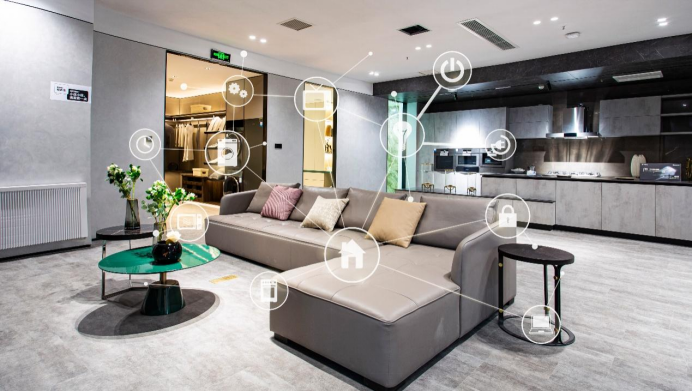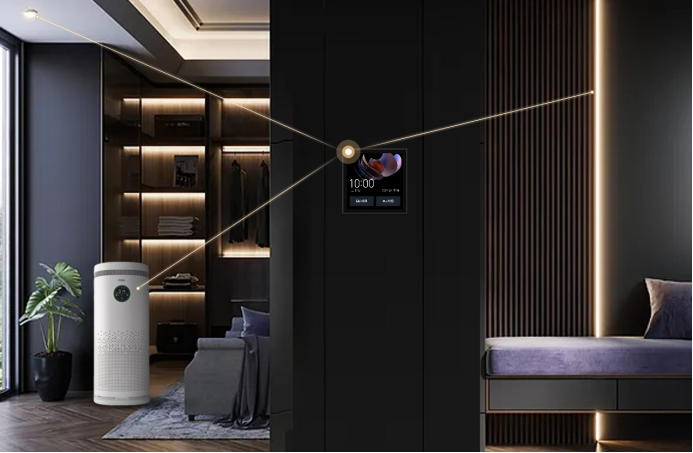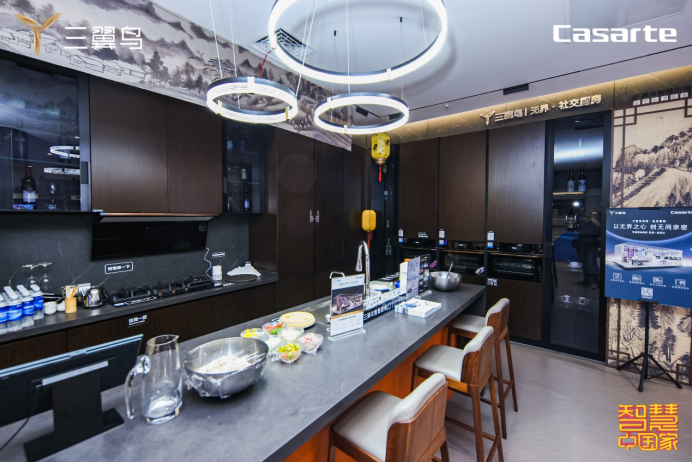To this day, topics related to new homes and renovations seem unable to exist independently of “smart homes.” According to monitoring data from AVC, the configuration rate of smart home systems in China’s refined decoration market increased by 2 percentage points from January to March 2022, with the configuration rates of smart locks, smart switches, and smart toilets increasing by 0.6%, 1.9%, and 3.8% respectively.
Smart homes have risen to become the “new infrastructure” of future residential consumption, implying a profound metaphor about contemporary consumer concepts: when the willingness to spend on “non-essential” large purchases is tepid, people’s attention is shifting towards “experiential consumption” that can directly enhance quality of life.


Behind the Rise of Packages Lies New Opportunities for Smart Homes
The smart home sector, which has always felt “distant yet close,” has finally welcomed a true era after more than a decade of gradual development. This judgment is based on the dual benefits provided by policies and the environment.
First, there is a favorable wind from the policy side. The “14th Five-Year Plan for Digital Economy Development” proposes to guide the interconnectivity of smart home products and promote intelligent interaction between home products and the home environment; during the Two Sessions, digitalization became a high-frequency term, and the aging adaptation of smart homes attracted attention; even more, provinces like Anhui have set key goals for the smart home industry, planning to build no less than 10,000 standardized demonstration residential systems for smart homes by the end of 2025.
The reason for national regulation stems from the increasingly intense trend of consumer upgrades, which is also a crucial factor supporting the rise of smart homes. When discussing contemporary consumption trends, the “intelligent” aspect related to the Internet of Things and the “quality” aspect related to society together form the two poles of demand for smart home consumption.
The surge in popularity of floor washing machines, vacuum cleaners, projectors, water purifiers, etc., during the pandemic has opened the curtain for the entry of small smart home devices.. As market education has matured, the more systematic demand for “whole-house intelligence” is taking center stage, with market growth points shifting from traditional smart speakers and locks to multi-dimensional coverage of smart refrigerators, smart air conditioners, and all-in-one gateways.
Whether from policy guidance or consumer trends, they convey a message: smart homes have reached a critical juncture for large-scale implementation.


The Trillion-Yuan Market Cake: Competitors Rush into Whole-House Intelligence
IDC data shows that China’s smart home shipment volume has surpassed 200 million units, and the global market value is expected to exceed $400 billion by 2025. Faced with this trillion-level cake, companies are already in a state of “the storm is coming,” and under the drive of national policies and consumer enthusiasm, the frequency of competition among enterprises in the eye of the storm is accelerating.
As of today, “whole-house intelligence” has become a stronghold for leading players like Huawei, Haier Smart Home, and Xiaomi to compete. Each company’s layout logic is flourishing based on its own advantages.
Specifically, Huawei focuses more on building underlying connections and unified standards. Last April, it proposed the “1+2+N” whole-house smart solution, which has been upgraded again this year. The core of this solution is the whole-house smart host SE, which can help users achieve a set for each home and full-house connectivity. Overall, to ensure the whole-house smart experience, Huawei emphasizes the pre-installation of smart devices before renovation.
In contrast, Xiaomi adheres to a consistent “post-installation, lightweight” style. For users who have already completed renovations, choosing Xiaomi’s small products like speakers, locks, and lighting does not require structural modifications, and the vast product library can meet the needs of various scenarios throughout the house. It can be said that Xiaomi’s “two-way open” model, which outputs a full range of products to the market while accepting products from other brands for interconnectivity, has one core principle: “the more products, the better.”
In addition to Huawei and Xiaomi, in recent years, new companies such as Orvibo, LifeSmart, and Ezviz have also been heavily investing in whole-house intelligence. However, from their specific actions, it is evident that these companies bear the influence of Huawei and Xiaomi, either delving into connections with soft technology or accelerating product line expansion to build a continuously enriched self-connected smart system.
Ultimately, the current focus of the industry is almost entirely centered around “connecting more hardware.” However, one company has taken a different path by focusing on the entire process experience, which is Three Wings Bird.
In May of this year, Three Wings Bird launched the “1+3+5+N” whole-house smart all-scenario solution. At first glance, this seems similar to Huawei’s “1+2+N” and Orvibo’s “1+4+N.” However, Three Wings Bird’s “1,” which is the smart home brain, does not serve to connect all house hardware like Huawei’s host, nor is it an entry point similar to Orvibo’s “whole-house control center,” but rather empowers all house products to provide “proactive services” as its core.
This brings it three differentiated capabilities. First is proactive service, which differs from the common ability of “humans giving commands and products executing them”; for example, Three Wings Bird’s refrigerator can recommend recipes based on user needs, and the air conditioner can dynamically adjust temperature and humidity when a person falls asleep. Second is all-scenario capability, as Three Wings Bird can provide all-scenario options for different family needs such as elites, middle-class, and families with two children, thanks to its strong foundation of full categories and brands. Third is unlimited customization; while most companies can only customize products and services, Three Wings Bird can provide full-process customization services from early design, mid-stage construction, to later home appliance matching, covering everything from start to finish.


Who Will Last Until the End? The Market Gives Its Attitude Through Trends
As far as the eye can see, everyone is fighting in the “whole-house intelligence” traffic pool, and the smart home market is a battlefield with many heroes, each showcasing their strengths. However, it is important to note that previously, 80% of smart home applications in China were in the real estate channel, and as the real estate dividends stabilize, who will bear the burden of 80% of the Chinese smart home market?
Ultimately, every industry, after experiencing a certain degree of rampant growth, will inevitably enter a phase of stable development based on consensus. This also means that the current flourishing competitive landscape will eventually yield one final winner. Although we cannot yet assert who will be the ultimate answer, the market has already expressed its attitude towards some erroneous logics.
First, whole-house intelligence is not the same as whole-house smart appliances; the difference lies in “overall” versus “individual.” Whole-house intelligence, in essence, aims to “detach from human control,” allowing products to serve independently rather than passively receiving commands. Second, the future true ToC market requires companies to possess full-process service capabilities from pre-installation, mid-installation, to post-installation and even lifelong service; focusing solely on a single area, such as just making connections or just making products, undoubtedly limits one to the downstream and makes it difficult to grasp the initiative. Third, ecology is a necessary path, but the essence of ecology is to expand boundaries, not to enclose or restrict.
Currently, many companies’ ecosystems consist of complementary collaborations between hardware and platforms or software and hardware in the same field, rather than win-win collaborations where 1+1>2. What is win-win? For instance, Haier Smart Home’s scenario brand Three Wings Bird has integrated cross-border resources such as home decoration, building materials, and daily necessities, providing not only smart products but also covering users’ various life needs in clothing, food, housing, and entertainment, allowing services to continuously extend in breadth and depth, tapping into users’ lifelong value.
Today, smart homes are fully welcoming favorable conditions, and the market is waiting for the flowers to bloom. However, this is also a fork in the road, a critical juncture that distinguishes leaders from followers.
Once companies become obsessed with interpreting the literal meaning of “whole-house intelligence” to showcase their strengths, while detaching from the essence of user experience, they risk becoming obsolete in the self-purification of the industry as it flows into the sea, along with the changing demands of users.

What Others Are Watching:
Smart homes are evolving into what people want
Daily revenue sharply reduced by tens of millions, mass layoffs! Information flow advertising agents are at a crossroads
LanTu’s sales halved, Dongfeng’s high-end dream shattered
Backed by two giants, Jidu Auto faces three major challenges
I achieved sock freedom in my hometown in Northeast China
Will the trillion-yuan marathon disappear? How to break through in the post-pandemic era
The Outlook Think Tank releases a report focusing on the development of rural e-commerce: new e-commerce continues to support the mainstream development of agricultural products
